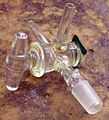Stopcock

A stopcock is a form of valve used to control the flow of a liquid or gas. The term is not precise and is applied to many different types of valve. The only consistent attribute is that the valve is designed to completely stop the flow when closed fully.
Use
Water service
Stopcocks are used to grossly regulate the flow of
Medical
Stopcocks are often used in medicine as a component of apparatus used in procedures such as intracranial pressure monitoring and other solution delivery procedures where varying amounts of liquid must be released without direct use of a syringe.[2]
Laboratory

For
Special stopcocks are available, such as a double-oblique or three-way design used in Schlenk lines which permit the application of inert gas and vacuum from the same stopcock.[4]
Stopcocks are often parts of laboratory glassware such as
Stopcocks are generally available individually with some length of glass tubing at the ports so that they can be joined by a glass blower into custom apparatus at the point of use. This is especially common for the large glass manifolds used in high vacuum lines. Many additional variations exist in both plug boring and joint assembly. Stopcocks have been manufactured for laboratory use since at least the start of the 20th century.[5]
Types of laboratory stopcocks
- 1-, 2- and 3-way stopcocks
- Needle valve stopcocks straight or right-angled
- Burette stopcocks straight or lateral
- Desiccator stopcocks
- Vacuum stopcocks one-way straight or parallel, one-way right-angled or 2-way
Gallery
-
A straight bore plastic stopcock without the female joint. Note its washer and nut system for attaching to its female joint.
-
A T-bore glass stopcock in a three way assembly. Two of the outlets end in plain hose adapters while the third ends in a male 14/20 ground glass joint. This stopcock is attached with an easily removed metal spring.
-
A double oblique bore glass three-way stopcock
-
A stopcock in the open position, connected to theoil bubblervia a short hose
-
A stopcock on a steam engine
-
A cast-iron City of Birmingham stopcock cover, on the boundary of a residential property, from the time when the City Council was responsible for the supply of drinking water.
References
- ^ Horsman, Paul (March 6, 2020). "What's a stopcock and what does it do?". Direct Line.
- ISBN 978-1-9751-2083-2.
- ^ ISBN 978-1-4200-5670-9.
- ISBN 978-0-471-86773-9.
- ^ Office, Canada Patent (1911). Scientific Canadian Mechanics' Magazine and Patent Office Record. p. 961.
External links
 Media related to Stopcocks at Wikimedia Commons
Media related to Stopcocks at Wikimedia Commons






